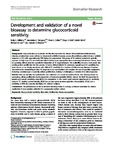Development and validation of a novel bioassay to determine glucocorticoid sensitivity
| dc.contributor.author | Williams, EL | |
| dc.contributor.author | Stimpson, ML | |
| dc.contributor.author | Collins, PL | |
| dc.contributor.author | Enki, Doyo Gragn | |
| dc.contributor.author | Sinha, A | |
| dc.contributor.author | Lee, RW | |
| dc.contributor.author | Dhanda, Ashwin | |
| dc.date.accessioned | 2016-12-20T12:14:39Z | |
| dc.date.available | 2016-12-20T12:14:39Z | |
| dc.date.issued | 2016-12-15 | |
| dc.identifier.issn | 2050-7771 | |
| dc.identifier.issn | 2050-7771 | |
| dc.identifier.other | 26 | |
| dc.identifier.uri | http://hdl.handle.net/10026.1/8146 | |
| dc.description.abstract |
BACKGROUND: Glucocorticoids (GCs) remain the first line treatment for almost all non-infectious inflammatory diseases, ranging from acute asthma to rheumatoid arthritis. However, across all conditions, patients have a variable response to GCs with approximately 30% being non-responders. This group of GC resistant patients is typically exposed to high-dose GCs and their side-effects before more appropriate immunotherapy is instituted. Hence, there is a pressing clinical need for a predictive biomarker of GC responsiveness. The availability of such a tool would also enable patient stratification for the conduct of smart clinical trials in GC resistance. Lymphocyte GC sensitivity has been shown to be closely associated with clinical GC sensitivity in a number of inflammatory diseases. However, the method for determining in vitro GC response is not standardized and requires the use of specialist equipment, including a radioisotope to quantify cellular proliferation, making it challenging to translate into clinical practice. RESULTS: Here we describe the optimization and validation of a novel non-radioactive in vitro bioassay based on measuring cellular proliferation by incorporation of bromodeoxyuridine (BrdU), termed the BrdU incorporation in lymphocyte steroid sensitivity assay (BLISS). In comparison to the current gold standard lymphocyte GC sensitivity assay in 101 healthy control samples, BLISS has an area under receiver operating characteristic of 0.82 and a sensitivity of 83% for correctly identifying GC resistant subjects. CONCLUSIONS: The performance of the novel BLISS bioassay makes it a strong candidate biomarker for clinical application. It now requires validation in a prospective patient cohort. | |
| dc.format.extent | 26-26 | |
| dc.format.medium | Electronic-eCollection | |
| dc.language | en | |
| dc.language.iso | en | |
| dc.publisher | Springer Science and Business Media LLC | |
| dc.subject | Biomarker | |
| dc.subject | Bromodeoxyuridine | |
| dc.subject | Glucocorticoid sensitivity | |
| dc.subject | Proliferation | |
| dc.title | Development and validation of a novel bioassay to determine glucocorticoid sensitivity | |
| dc.type | journal-article | |
| dc.type | Journal Article | |
| plymouth.author-url | https://www.ncbi.nlm.nih.gov/pubmed/27999674 | |
| plymouth.issue | 1 | |
| plymouth.volume | 4 | |
| plymouth.publication-status | Published | |
| plymouth.journal | Biomarker Research | |
| dc.identifier.doi | 10.1186/s40364-016-0079-y | |
| plymouth.organisational-group | /Plymouth | |
| plymouth.organisational-group | /Plymouth/Faculty of Health | |
| plymouth.organisational-group | /Plymouth/Faculty of Health/Peninsula Medical School | |
| plymouth.organisational-group | /Plymouth/REF 2021 Researchers by UoA | |
| plymouth.organisational-group | /Plymouth/REF 2021 Researchers by UoA/UoA01 Clinical Medicine | |
| plymouth.organisational-group | /Plymouth/REF 2021 Researchers by UoA/UoA01 Clinical Medicine/UoA01 Clinical Medicine | |
| plymouth.organisational-group | /Plymouth/REF 2021 Researchers by UoA/UoA03 Allied Health Professions, Dentistry, Nursing and Pharmacy | |
| plymouth.organisational-group | /Plymouth/Research Groups | |
| plymouth.organisational-group | /Plymouth/Research Groups/Institute of Health and Community | |
| plymouth.organisational-group | /Plymouth/Research Groups/Institute of Translational and Stratified Medicine (ITSMED) | |
| plymouth.organisational-group | /Plymouth/Research Groups/Institute of Translational and Stratified Medicine (ITSMED)/CBBB | |
| plymouth.organisational-group | /Plymouth/Research Groups/Plymouth Institute of Health and Care Research (PIHR) | |
| plymouth.organisational-group | /Plymouth/Users by role | |
| plymouth.organisational-group | /Plymouth/Users by role/Academics | |
| dc.publisher.place | England | |
| dcterms.dateAccepted | 2016-12-02 | |
| dc.identifier.eissn | 2050-7771 | |
| dc.rights.embargoperiod | Not known | |
| rioxxterms.versionofrecord | 10.1186/s40364-016-0079-y | |
| rioxxterms.licenseref.uri | http://www.rioxx.net/licenses/all-rights-reserved | |
| rioxxterms.licenseref.startdate | 2016-12-15 | |
| rioxxterms.type | Journal Article/Review | |
| plymouth.oa-location | https://biomarkerres.biomedcentral.com/articles/10.1186/s40364-016-0079-y |


